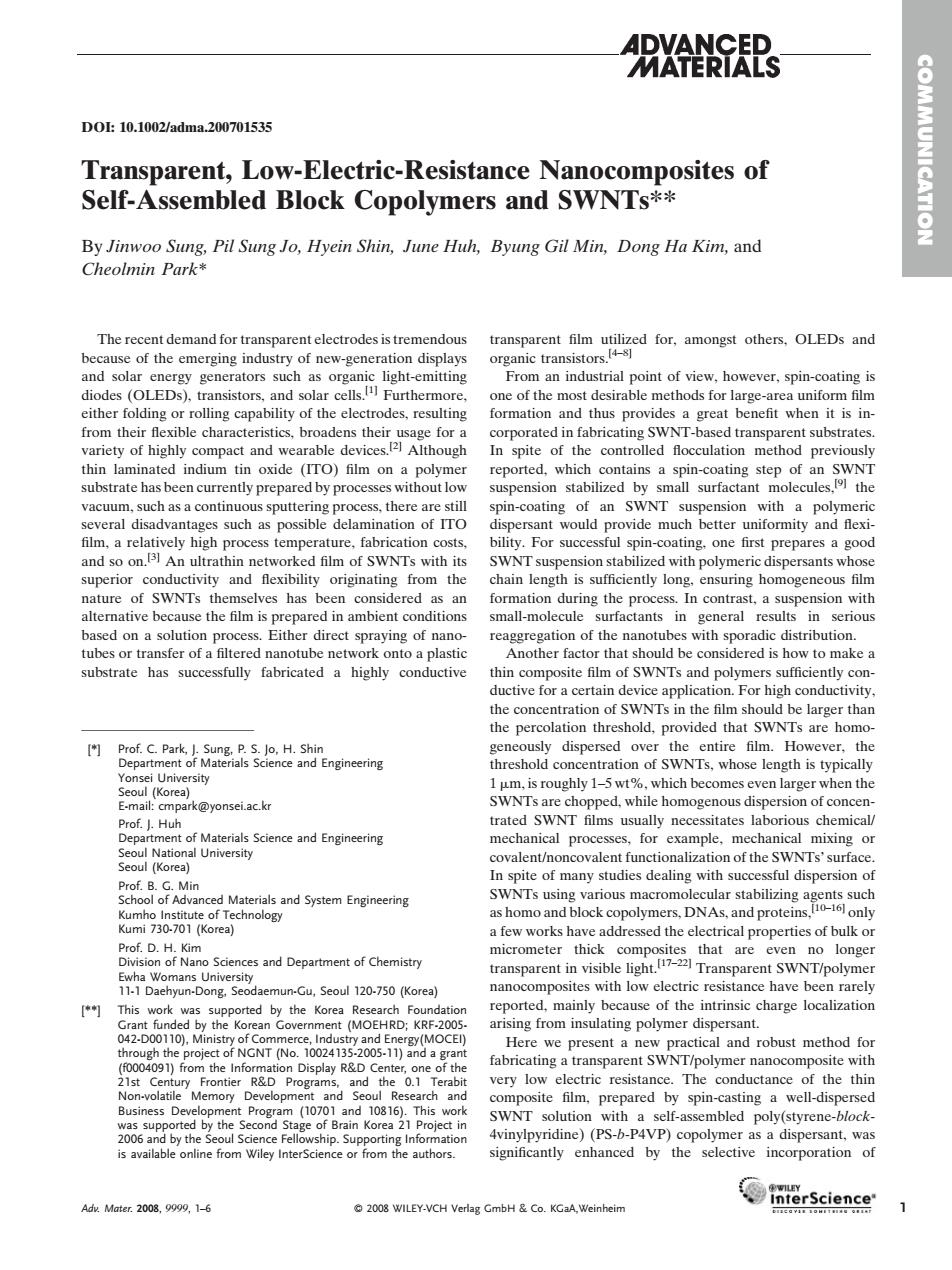正在加载图片...

AERTAS 8 D0L10.1002adma.20070153 Transparent,Low-Electric-Resistance Nanocomposites of Self-Assembled Block Copolymers and SWNTs** By Jinwoo Sung,Pil Sung Jo,Hyein Shin,June Huh,Byung Gil Min,Dong Ha Kim,and Cheolmin Park The recent demand for trar ran ent film because of the emerging industry of new-generation displays an industrial point of.spin coating is corporated in fabricating SWNT-based transparent substrates mpac In spite the cont prev substrate has been currently prepared by processes without ow spin-coating of an SWNT suspension with a polymeric ilm a relatively high process temperature.fabrication cos bility.For successful spin-coating.one first epares a go and so oAn ultrathin networkedm of SWNTs with its SWNT suspension stabilized with polymeric dispersants whose an red se the film is pared in ambient conditions small-moleculc surfactants in neral results in serious substrate has successfully fabricated a highly conductive thin compositeilm of SWNTs and polymers sufficiently con ductive for a certain device application.For high conductivity the entire film.However Engineering cntrat on of SWNTs.whose length is typically (o Prof.Huh ence and Engineering als and s Engineering a few works have addressed the electricalp s and Department of Chemistry micrometer ig that are even no longer ransparent i -Gu,Seoul 120-750 (Korea) reported,mainly because of the intrinsic charge localization RD:KR ing from insulating polymer dispersant 1 Tpolymer nanoce very low e ctric film,prepared by spin ess D dby the Se Adv Mater..2008.9999,16 2008 WILEY-VCH Verlag GmbH Co.KGaA,Weinheim iterScience DOI: 10.1002/adma.200701535 Transparent, Low-Electric-Resistance Nanocomposites of Self-Assembled Block Copolymers and SWNTs** By Jinwoo Sung, Pil Sung Jo, Hyein Shin, June Huh, Byung Gil Min, Dong Ha Kim, and Cheolmin Park* The recent demand for transparent electrodes is tremendous because of the emerging industry of new-generation displays and solar energy generators such as organic light-emitting diodes (OLEDs), transistors, and solar cells.[1] Furthermore, either folding or rolling capability of the electrodes, resulting from their flexible characteristics, broadens their usage for a variety of highly compact and wearable devices.[2] Although thin laminated indium tin oxide (ITO) film on a polymer substrate has been currently prepared by processes without low vacuum, such as a continuous sputtering process, there are still several disadvantages such as possible delamination of ITO film, a relatively high process temperature, fabrication costs, and so on.[3] An ultrathin networked film of SWNTs with its superior conductivity and flexibility originating from the nature of SWNTs themselves has been considered as an alternative because the film is prepared in ambient conditions based on a solution process. Either direct spraying of nanotubes or transfer of a filtered nanotube network onto a plastic substrate has successfully fabricated a highly conductive transparent film utilized for, amongst others, OLEDs and organic transistors.[4–8] From an industrial point of view, however, spin-coating is one of the most desirable methods for large-area uniform film formation and thus provides a great benefit when it is incorporated in fabricating SWNT-based transparent substrates. In spite of the controlled flocculation method previously reported, which contains a spin-coating step of an SWNT suspension stabilized by small surfactant molecules,[9] the spin-coating of an SWNT suspension with a polymeric dispersant would provide much better uniformity and flexibility. For successful spin-coating, one first prepares a good SWNT suspension stabilized with polymeric dispersants whose chain length is sufficiently long, ensuring homogeneous film formation during the process. In contrast, a suspension with small-molecule surfactants in general results in serious reaggregation of the nanotubes with sporadic distribution. Another factor that should be considered is how to make a thin composite film of SWNTs and polymers sufficiently conductive for a certain device application. For high conductivity, the concentration of SWNTs in the film should be larger than the percolation threshold, provided that SWNTs are homogeneously dispersed over the entire film. However, the threshold concentration of SWNTs, whose length is typically 1 mm, is roughly 1–5 wt%, which becomes even larger when the SWNTs are chopped, while homogenous dispersion of concentrated SWNT films usually necessitates laborious chemical/ mechanical processes, for example, mechanical mixing or covalent/noncovalent functionalization of the SWNTs’ surface. In spite of many studies dealing with successful dispersion of SWNTs using various macromolecular stabilizing agents such as homo and block copolymers, DNAs, and proteins,[10–16] only a few works have addressed the electrical properties of bulk or micrometer thick composites that are even no longer transparent in visible light.[17–22] Transparent SWNT/polymer nanocomposites with low electric resistance have been rarely reported, mainly because of the intrinsic charge localization arising from insulating polymer dispersant. Here we present a new practical and robust method for fabricating a transparent SWNT/polymer nanocomposite with very low electric resistance. The conductance of the thin composite film, prepared by spin-casting a well-dispersed SWNT solution with a self-assembled poly(styrene-block- 4vinylpyridine) (PS-b-P4VP) copolymer as a dispersant, was significantly enhanced by the selective incorporation of COMMUNICATION [*] Prof. C. Park, J. Sung, P. S. Jo, H. Shin Department of Materials Science and Engineering Yonsei University Seoul (Korea) E-mail: cmpark@yonsei.ac.kr Prof. J. Huh Department of Materials Science and Engineering Seoul National University Seoul (Korea) Prof. B. G. Min School of Advanced Materials and System Engineering Kumho Institute of Technology Kumi 730-701 (Korea) Prof. D. H. Kim Division of Nano Sciences and Department of Chemistry Ewha Womans University 11-1 Daehyun-Dong, Seodaemun-Gu, Seoul 120-750 (Korea) [**] This work was supported by the Korea Research Foundation Grant funded by the Korean Government (MOEHRD; KRF-2005- 042-D00110), Ministry of Commerce, Industry and Energy(MOCEI) through the project of NGNT (No. 10024135-2005-11) and a grant (f0004091) from the Information Display R&D Center, one of the 21st Century Frontier R&D Programs, and the 0.1 Terabit Non-volatile Memory Development and Seoul Research and Business Development Program (10701 and 10816). This work was supported by the Second Stage of Brain Korea 21 Project in 2006 and by the Seoul Science Fellowship. Supporting Information is available online from Wiley InterScience or from the authors. Adv. Mater. 2008, 9999, 1–6 2008 WILEY-VCH Verlag GmbH & Co. KGaA,Weinheim 1